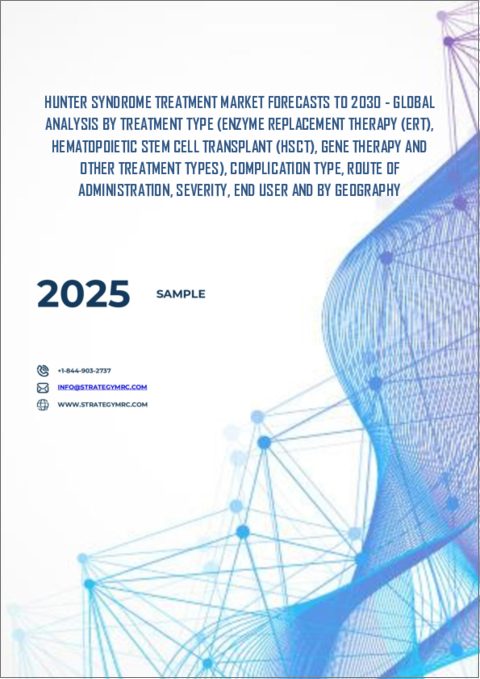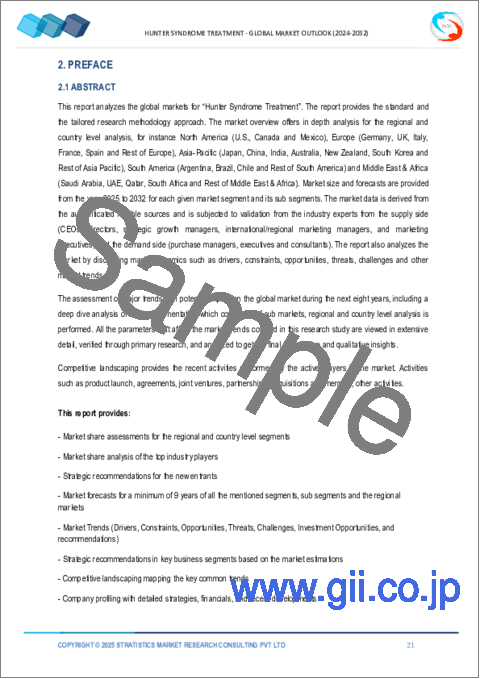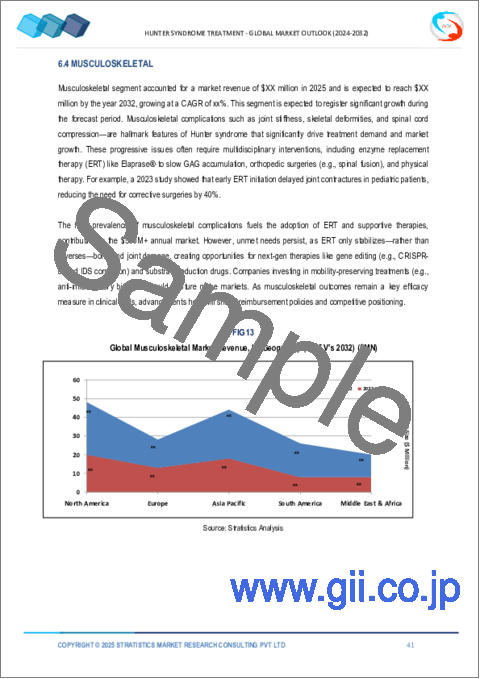|
|
市場調査レポート
商品コード
1587615
ハンター症候群治療市場の2030年までの予測:治療タイプ、合併症タイプ、投与経路、重症度、エンドユーザー、地域別の世界分析Hunter Syndrome Treatment Market Forecasts to 2030 - Global Analysis By Treatment Type, Complication Type, Route of Administration, Severity, End User and By Geography |
||||||
カスタマイズ可能
|
|||||||
| ハンター症候群治療市場の2030年までの予測:治療タイプ、合併症タイプ、投与経路、重症度、エンドユーザー、地域別の世界分析 |
|
出版日: 2024年11月11日
発行: Stratistics Market Research Consulting
ページ情報: 英文 200+ Pages
納期: 2~3営業日
|
全表示
- 概要
- 図表
- 目次
Stratistics MRCによると、世界のハンター症候群治療市場は2024年に13億米ドルを占め、予測期間中にCAGR 7.3%で成長し、2030年には19億米ドルに達すると予測されています。
ハンター症候群は、イデュロン酸-2-スルファターゼという酵素の欠損によって引き起こされる稀な遺伝性疾患で、進行性の健康問題を引き起こします。治療は主に、症状の管理と生活の質の改善に重点を置いています。酵素補充療法(ERT)は最も一般的なアプローチで、基質の蓄積を抑えるために欠乏した酵素を患者に投与します。その他の治療としては、運動機能を維持するための理学療法、呼吸困難に対処するための呼吸ケア、整形外科的問題や臓器機能支持のための外科的介入などがあります。
Genetic and Rare Diseases Information Center(GARD)によると、希少疾患は7,000種類あると推定され、米国におけるこれらの希少疾患の患者総数は2,500万~3,000万人です。
高まるハンター症候群への認識
ハンター症候群に対する認識の高まりは、早期診断と疾患に対するより深い理解を促進することで、治療市場を再構築しています。ヘルスケア専門家や擁護団体における教育の高まりは、酵素補充療法(ERT)のような革新的な治療法に対する需要に拍車をかけています。このような認識は利害関係者間の協力を促進し、患者支援と転帰を向上させ、最終的には治療選択肢を拡大し、本疾患に罹患している人々の全体的な状況を改善します。
熟練した専門家の不足
市場における熟練した専門家の不足は重大な課題であり、診断の遅れや患者への最適な治療とはいえない治療につながっています。専門知識の不足は、酵素補充療法や遺伝子治療などの革新的な治療法の効果的な実施を妨げる可能性があります。この不足は専門的治療へのアクセスを制限し、患者支援と全体的なケアの質を低下させる。その結果、健康格差が悪化し、本疾患に罹患した患者の転帰を改善する可能性が低下します。
ヘルスケア支出の増加
市場におけるヘルスケア支出の増加は、高度な治療と包括的ケアに対する需要の高まりを反映しています。認知度が高まるにつれ、酵素補充療法(ERT)や遺伝子治療への投資が拡大し、研究開発、患者管理に関連する費用が増加します。このような支出の急増は、治療へのアクセスや治療成績の向上を目指しているが、ヘルスケア予算を圧迫する可能性があります。結局のところ、持続可能な資金調達と、罹患者を効果的に支援する革新的なアプローチの必要性が浮き彫りになっています。
新興市場における認知度の低さ
新興市場におけるハンター症候群の認知度の低さは、治療の妨げとなり、診断の遅れや治療への不十分なアクセスを招いています。多くのヘルスケア提供者は、この疾患に関する知識が不足しているため、誤診や過小診断につながる可能性があります。このギャップは、革新的な治療法の利用を制限し、最終的に患者の転帰に影響を与えます。これらの地域の罹患者に対する認識と支援を向上させるためには、教育とアドボカシーの強化が不可欠です。
COVID-19の影響:
COVID-19パンデミックは、ヘルスケアサービスを中断させ、必要不可欠な治療法へのアクセスを制限することで、市場に悪影響を与えました。定期的な受診が延期され、多くの患者の診断と治療開始が遅れました。さらに、サプライチェーンの混乱は酵素補充療法の入手にも影響を与えました。パンデミック対応に注力した結果、希少疾患からリソースがシフトし、ハンター症候群のような希少疾患の患者に対するケアの継続を優先する回復力のあるヘルスケアシステムの必要性が浮き彫りになった。
予測期間中、筋骨格系セグメントが最大と予測される
筋骨格系セグメントは予測期間中最大の市場シェアを占めると予測されます。患者は、これらの合併症に対処するために、理学療法、整形外科手術、疼痛管理戦略などの介入を必要とする場合があります。筋骨格系の症状に対する理解が深まるにつれ、専門的な治療や集学的なケアアプローチに対する需要が高まっています。効果的な管理は、患者のQOLと全体的な機能的転帰を改善するために極めて重要です。
診断センター部門は予測期間中最も高いCAGRが見込まれる
診断センター分野は、予測期間中に最も高いCAGRを示すと予想されます。遺伝子検査や酵素アッセイを含む高度な検査法は、障害の確認に不可欠です。診断センターとヘルスケアプロバイダーとの連携強化により、認知度が向上し、タイムリーな介入が促進されます。希少遺伝性疾患に特化したセンターが増えるにつれ、患者の転帰の改善や標的治療へのアクセスの向上に寄与し、最終的には罹患者のケアも進歩します。
最大のシェアを占める地域
予測期間中、北米地域が最大の市場シェアを占めると予測されます。酵素補充療法(ERT)は、現在進行中の臨床研究や患者支援活動によって支持を得ています。専門的な治療や診断サービスへのアクセスは向上しているが、費用や保険適用の面で課題が残っています。ヘルスケアプロバイダー、製薬会社、アドボカシーグループの連携は、この地域における患者の転帰を向上させる上で極めて重要です。
CAGRが最も高い地域:
アジア太平洋地域は、遺伝性疾患の有病率の増加により、予測期間中に最も高い成長率を記録すると予想されます。同市場は、ERT、幹細胞移植、外科的介入など多様な治療方法によって特徴付けられるが、関節の可動性や顔の粗さなどの症状を管理する有効性から、現在ERTが優位を占めています。日本や中国などの国々は、早期診断と希少疾患に対する認識の向上から恩恵を受け、この分野をリードしています。
無料カスタマイズサービス:
本レポートをご購読のお客様には、以下の無料カスタマイズオプションのいずれかをご利用いただけます:
- 企業プロファイル
- 追加市場プレーヤーの包括的プロファイリング(3社まで)
- 主要企業のSWOT分析(3社まで)
- 地域セグメンテーション
- 顧客の関心に応じた主要国の市場推計・予測・CAGR(注:フィージビリティチェックによる)
- 競合ベンチマーキング
- 製品ポートフォリオ、地理的プレゼンス、戦略的提携に基づく主要企業のベンチマーキング
目次
第1章 エグゼクティブサマリー
第2章 序文
- 概要
- ステークホルダー
- 調査範囲
- 調査手法
- データマイニング
- データ分析
- データ検証
- 調査アプローチ
- 調査情報源
- 1次調査情報源
- 2次調査情報源
- 前提条件
第3章 市場動向分析
- 促進要因
- 抑制要因
- 機会
- 脅威
- エンドユーザー分析
- 新興市場
- COVID-19の影響
第4章 ポーターのファイブフォース分析
- 供給企業の交渉力
- 買い手の交渉力
- 代替品の脅威
- 新規参入業者の脅威
- 競争企業間の敵対関係
第5章 世界のハンター症候群治療市場:治療タイプ別
- 酵素補充療法(ERT)
- 造血幹細胞移植(HSCT)
- 遺伝子治療
- その他の治療の種類
第6章 ハンター症候群治療の世界市場:合併症タイプ別
- 心臓血管
- 呼吸器
- 筋骨格
- 神経学的
- 眼科
- 肝臓
- 腎臓
- 血液学
- その他の合併症タイプ
第7章 世界のハンター症候群治療市場:投与経路別
- 静脈内(IV)
- 脳室内(ICV)
第8章 世界のハンター症候群治療市場:重症度別
- 軽度
- 中度
- 重度
第9章 世界のハンター症候群治療市場:エンドユーザー別
- 病院
- 診断センター
- 専門クリニック
- 在宅ケア環境
- その他のエンドユーザー
第10章 世界のハンター症候群治療市場:地域別
- 北米
- 米国
- カナダ
- メキシコ
- 欧州
- ドイツ
- 英国
- イタリア
- フランス
- スペイン
- その他欧州
- アジア太平洋
- 日本
- 中国
- インド
- オーストラリア
- ニュージーランド
- 韓国
- その他アジア太平洋地域
- 南米
- アルゼンチン
- ブラジル
- チリ
- その他南米
- 中東・アフリカ
- サウジアラビア
- アラブ首長国連邦
- カタール
- 南アフリカ
- その他中東とアフリカ
第11章 主な発展
- 契約、パートナーシップ、コラボレーション、合弁事業
- 買収と合併
- 新製品発売
- 事業拡大
- その他の主要戦略
第12章 企業プロファイリング
- Takeda Pharmaceutical Company Limited
- Medtronic
- CANbridge Life Sciences Ltd.
- Novartis AG
- Zimmer Biomet
- Sangamo Therapeutics
- F. Hoffmann-La Roche Ltd
- Jasper Therapeutics, Inc.
- GSK Plc.
- Denali Therapeutics
- Abbott
- JCR Pharmaceuticals Co., Ltd.
- Bayer AG
- Johnson & Johnson Services, Inc.
- Stryker Corporation
List of Tables
- Table 1 Global Hunter Syndrome Treatment Market Outlook, By Region (2022-2030) ($MN)
- Table 2 Global Hunter Syndrome Treatment Market Outlook, By Treatment Type (2022-2030) ($MN)
- Table 3 Global Hunter Syndrome Treatment Market Outlook, By Enzyme Replacement Therapy (ERT) (2022-2030) ($MN)
- Table 4 Global Hunter Syndrome Treatment Market Outlook, By Hematopoietic Stem Cell Transplant (HSCT) (2022-2030) ($MN)
- Table 5 Global Hunter Syndrome Treatment Market Outlook, By Gene Therapy (2022-2030) ($MN)
- Table 6 Global Hunter Syndrome Treatment Market Outlook, By Other Treatment Types (2022-2030) ($MN)
- Table 7 Global Hunter Syndrome Treatment Market Outlook, By Complication Type (2022-2030) ($MN)
- Table 8 Global Hunter Syndrome Treatment Market Outlook, By Cardiovascular (2022-2030) ($MN)
- Table 9 Global Hunter Syndrome Treatment Market Outlook, By Respiratory (2022-2030) ($MN)
- Table 10 Global Hunter Syndrome Treatment Market Outlook, By Musculoskeletal (2022-2030) ($MN)
- Table 11 Global Hunter Syndrome Treatment Market Outlook, By Neurological (2022-2030) ($MN)
- Table 12 Global Hunter Syndrome Treatment Market Outlook, By Ocular (2022-2030) ($MN)
- Table 13 Global Hunter Syndrome Treatment Market Outlook, By Hepatic (2022-2030) ($MN)
- Table 14 Global Hunter Syndrome Treatment Market Outlook, By Renal (2022-2030) ($MN)
- Table 15 Global Hunter Syndrome Treatment Market Outlook, By Hematological (2022-2030) ($MN)
- Table 16 Global Hunter Syndrome Treatment Market Outlook, By Other Complication Types (2022-2030) ($MN)
- Table 17 Global Hunter Syndrome Treatment Market Outlook, By Route of Administration (2022-2030) ($MN)
- Table 18 Global Hunter Syndrome Treatment Market Outlook, By Intravenous (IV) (2022-2030) ($MN)
- Table 19 Global Hunter Syndrome Treatment Market Outlook, By Intracerebroventricular (ICV) (2022-2030) ($MN)
- Table 20 Global Hunter Syndrome Treatment Market Outlook, By Severity (2022-2030) ($MN)
- Table 21 Global Hunter Syndrome Treatment Market Outlook, By Mild (2022-2030) ($MN)
- Table 22 Global Hunter Syndrome Treatment Market Outlook, By Moderate (2022-2030) ($MN)
- Table 23 Global Hunter Syndrome Treatment Market Outlook, By Severe (2022-2030) ($MN)
- Table 24 Global Hunter Syndrome Treatment Market Outlook, By End User (2022-2030) ($MN)
- Table 25 Global Hunter Syndrome Treatment Market Outlook, By Hospitals (2022-2030) ($MN)
- Table 26 Global Hunter Syndrome Treatment Market Outlook, By Diagnostic Centers (2022-2030) ($MN)
- Table 27 Global Hunter Syndrome Treatment Market Outlook, By Specialty Clinics (2022-2030) ($MN)
- Table 28 Global Hunter Syndrome Treatment Market Outlook, By Homecare Settings (2022-2030) ($MN)
- Table 29 Global Hunter Syndrome Treatment Market Outlook, By Other End Users (2022-2030) ($MN)
Note: Tables for North America, Europe, APAC, South America, and Middle East & Africa Regions are also represented in the same manner as above.
According to Stratistics MRC, the Global Hunter Syndrome Treatment Market is accounted for $1.3 billion in 2024 and is expected to reach $1.9 billion by 2030 growing at a CAGR of 7.3% during the forecast period. Hunter Syndrome, a rare genetic disorder caused by a deficiency of the enzyme iduronate-2-sulfatase, leads to progressive health issues. Treatment primarily focuses on managing symptoms and improving quality of life. Enzyme replacement therapy (ERT) is the most common approach, providing patients with the missing enzyme to reduce substrate accumulation. Additional treatments may include physical therapy to maintain mobility, respiratory care to address breathing difficulties, and surgical interventions for orthopedic issues or organ function support.
According to the Genetic and Rare Diseases Information Center (GARD), there can be an estimated 7,000 rare diseases and the total number of individuals in the U.S. from these rare diseases can be 25-30 million.
Market Dynamics:
Driver:
Growing awareness of hunter syndrome
Growing awareness of Hunter Syndrome is reshaping the treatment market by promoting earlier diagnoses and a deeper understanding of the condition. Increased education among healthcare professionals and advocacy groups has spurred demand for innovative therapies, such as enzyme replacement therapy (ERT). This awareness fosters collaboration among stakeholders, enhancing patient support and outcomes, ultimately expanding treatment options and improving the overall landscape for those affected by the disorder.
Restraint:
Lack of skilled professionals
The lack of skilled professionals in the market poses significant challenges, leading to delayed diagnoses and suboptimal care for patients. Insufficient expertise can hinder effective implementation of innovative therapies, such as enzyme replacement and gene therapies. This shortage limits access to specialized treatment, reducing patient support and overall quality of care. Consequently, it exacerbates health disparities and diminishes the potential for improved outcomes in individuals affected by the disorder.
Opportunity:
Increased healthcare expenditure
Increased healthcare expenditure in the market reflects the rising demand for advanced therapies and comprehensive care. As awareness grows, investments in enzyme replacement therapy (ERT) and gene therapies expand, driving up costs associated with research, development, and patient management. This surge in spending aims to improve treatment accessibility and outcomes but may strain healthcare budgets. Ultimately, it highlights the need for sustainable funding and innovative approaches to support affected individuals effectively.
Threat:
Limited awareness in emerging markets
Limited awareness of Hunter Syndrome in emerging markets significantly hinders the treatment landscape, resulting in delayed diagnoses and inadequate access to care. Many healthcare providers may lack knowledge about the disorder, leading to misdiagnosis or underdiagnosis. This gap restricts the availability of innovative therapies ultimately impacting patient outcomes. Increased education and advocacy are essential to improve awareness and support for affected individuals in these regions.
Covid-19 Impact:
The COVID-19 pandemic adversely impacted the market by disrupting healthcare services and limiting access to essential therapies. Routine medical visits were postponed, delaying diagnoses and treatment initiation for many patients. Additionally, supply chain disruptions affected the availability of enzyme replacement therapies. The focus on pandemic response shifted resources away from rare diseases, highlighting the need for resilient healthcare systems that prioritize continuity of care for patients with rare conditions like Hunter Syndrome.
The musculoskeletal segment is projected to be the largest during the forecast period
The musculoskeletal segment is projected to account for the largest market share during the projection period. Patients may require interventions such as physical therapy, orthopedic surgeries, and pain management strategies to address these complications. The growing understanding of musculoskeletal manifestations drives demand for specialized treatments and multidisciplinary care approaches. Effective management is crucial to improving patients' quality of life and overall functional outcomes.
The diagnostic centers segment is expected to have the highest CAGR during the forecast period
The diagnostic centers segment is expected to have the highest CAGR during the extrapolated period. Advanced testing methods, including genetic testing and enzyme assays, are essential for confirming the disorder. Increased collaboration between diagnostic centers and healthcare providers enhances awareness and promotes timely intervention. As more centers specialize in rare genetic disorders, they contribute to improved patient outcomes and better access to targeted therapies, ultimately advancing care for those affected.
Region with largest share:
North America region is projected to account for the largest market share during the forecast period. Enzyme replacement therapy (ERT) has gained traction, supported by ongoing clinical research and patient advocacy efforts. Access to specialized care and diagnostic services is improving, although challenges remain in terms of cost and insurance coverage. The collaboration among healthcare providers, pharmaceutical companies, and advocacy groups is crucial for enhancing patient outcomes in the region.
Region with highest CAGR:
Asia Pacific is expected to register the highest growth rate over the forecast period due to increasing prevalence of genetic disorders. The market is characterized by diverse treatment modalities, including ERT, stem cell transplants, and surgical interventions, with ERT currently dominating due to its efficacy in managing symptoms like joint mobility and facial coarseness. Countries such as Japan and China are leading the charge, benefiting from early diagnosis and increased awareness of rare diseases.
Key players in the market
Some of the key players in Hunter Syndrome Treatment market include Takeda Pharmaceutical Company Limited, Medtronic, CANbridge Life Sciences Ltd., Novartis AG, Zimmer Biomet, Sangamo Therapeutics, F. Hoffmann-La Roche Ltd, Jasper Therapeutics, Inc., GSK Plc., Denali Therapeutics, Abbott, JCR Pharmaceuticals Co., Ltd. , Bayer AG, Johnson & Johnson Services, Inc. and Stryker Corporation.
Key Developments:
In September 2024, Denali Therapeutics announced plans to seek accelerated FDA approval for its investigational treatment, DNL310, to address Hunter syndrome (MPS II). Following productive discussions with the FDA, the company is set to submit a Biologics License Application (BLA) by early 2025.
In January 2024, Clinigen Group plc announced that it had received manufacturing and marketing approval for Hunterase (Disulfate-beta) ICV 15mg, under its strategic alliance with GC Pharma in Japan. This approval may help the company to acquire an enhanced customer base.
Treatment Types Covered:
- Enzyme Replacement Therapy (ERT)
- Hematopoietic Stem Cell Transplant (HSCT)
- Gene Therapy
- Other Treatment Types
Complication Types Covered:
- Cardiovascular
- Respiratory
- Musculoskeletal
- Neurological
- Ocular
- Hepatic
- Renal
- Hematological
- Other Complication Types
Route of Administration Covered:
- Intravenous (IV)
- Intracerebroventricular (ICV)
Severity Covered:
- Mild
- Moderate
- Severe
End Users Covered:
- Hospitals
- Diagnostic Centers
- Specialty Clinics
- Homecare Settings
- Other End Users
Regions Covered:
- North America
- US
- Canada
- Mexico
- Europe
- Germany
- UK
- Italy
- France
- Spain
- Rest of Europe
- Asia Pacific
- Japan
- China
- India
- Australia
- New Zealand
- South Korea
- Rest of Asia Pacific
- South America
- Argentina
- Brazil
- Chile
- Rest of South America
- Middle East & Africa
- Saudi Arabia
- UAE
- Qatar
- South Africa
- Rest of Middle East & Africa
What our report offers:
- Market share assessments for the regional and country-level segments
- Strategic recommendations for the new entrants
- Covers Market data for the years 2022, 2023, 2024, 2026, and 2030
- Market Trends (Drivers, Constraints, Opportunities, Threats, Challenges, Investment Opportunities, and recommendations)
- Strategic recommendations in key business segments based on the market estimations
- Competitive landscaping mapping the key common trends
- Company profiling with detailed strategies, financials, and recent developments
- Supply chain trends mapping the latest technological advancements
Free Customization Offerings:
All the customers of this report will be entitled to receive one of the following free customization options:
- Company Profiling
- Comprehensive profiling of additional market players (up to 3)
- SWOT Analysis of key players (up to 3)
- Regional Segmentation
- Market estimations, Forecasts and CAGR of any prominent country as per the client's interest (Note: Depends on feasibility check)
- Competitive Benchmarking
- Benchmarking of key players based on product portfolio, geographical presence, and strategic alliances
Table of Contents
1 Executive Summary
2 Preface
- 2.1 Abstract
- 2.2 Stake Holders
- 2.3 Research Scope
- 2.4 Research Methodology
- 2.4.1 Data Mining
- 2.4.2 Data Analysis
- 2.4.3 Data Validation
- 2.4.4 Research Approach
- 2.5 Research Sources
- 2.5.1 Primary Research Sources
- 2.5.2 Secondary Research Sources
- 2.5.3 Assumptions
3 Market Trend Analysis
- 3.1 Introduction
- 3.2 Drivers
- 3.3 Restraints
- 3.4 Opportunities
- 3.5 Threats
- 3.6 End User Analysis
- 3.7 Emerging Markets
- 3.8 Impact of Covid-19
4 Porters Five Force Analysis
- 4.1 Bargaining power of suppliers
- 4.2 Bargaining power of buyers
- 4.3 Threat of substitutes
- 4.4 Threat of new entrants
- 4.5 Competitive rivalry
5 Global Hunter Syndrome Treatment Market, By Treatment Type
- 5.1 Introduction
- 5.2 Enzyme Replacement Therapy (ERT)
- 5.3 Hematopoietic Stem Cell Transplant (HSCT)
- 5.4 Gene Therapy
- 5.5 Other Treatment Types
6 Global Hunter Syndrome Treatment Market, By Complication Type
- 6.1 Introduction
- 6.2 Cardiovascular
- 6.3 Respiratory
- 6.4 Musculoskeletal
- 6.5 Neurological
- 6.6 Ocular
- 6.7 Hepatic
- 6.8 Renal
- 6.9 Hematological
- 6.10 Other Complication Types
7 Global Hunter Syndrome Treatment Market, By Route of Administration
- 7.1 Introduction
- 7.2 Intravenous (IV)
- 7.3 Intracerebroventricular (ICV)
8 Global Hunter Syndrome Treatment Market, By Severity
- 8.1 Introduction
- 8.2 Mild
- 8.3 Moderate
- 8.4 Severe
9 Global Hunter Syndrome Treatment Market, By End User
- 9.1 Introduction
- 9.2 Hospitals
- 9.3 Diagnostic Centers
- 9.4 Specialty Clinics
- 9.5 Homecare Settings
- 9.6 Other End Users
10 Global Hunter Syndrome Treatment Market, By Geography
- 10.1 Introduction
- 10.2 North America
- 10.2.1 US
- 10.2.2 Canada
- 10.2.3 Mexico
- 10.3 Europe
- 10.3.1 Germany
- 10.3.2 UK
- 10.3.3 Italy
- 10.3.4 France
- 10.3.5 Spain
- 10.3.6 Rest of Europe
- 10.4 Asia Pacific
- 10.4.1 Japan
- 10.4.2 China
- 10.4.3 India
- 10.4.4 Australia
- 10.4.5 New Zealand
- 10.4.6 South Korea
- 10.4.7 Rest of Asia Pacific
- 10.5 South America
- 10.5.1 Argentina
- 10.5.2 Brazil
- 10.5.3 Chile
- 10.5.4 Rest of South America
- 10.6 Middle East & Africa
- 10.6.1 Saudi Arabia
- 10.6.2 UAE
- 10.6.3 Qatar
- 10.6.4 South Africa
- 10.6.5 Rest of Middle East & Africa
11 Key Developments
- 11.1 Agreements, Partnerships, Collaborations and Joint Ventures
- 11.2 Acquisitions & Mergers
- 11.3 New Product Launch
- 11.4 Expansions
- 11.5 Other Key Strategies
12 Company Profiling
- 12.1 Takeda Pharmaceutical Company Limited
- 12.2 Medtronic
- 12.3 CANbridge Life Sciences Ltd.
- 12.4 Novartis AG
- 12.5 Zimmer Biomet
- 12.6 Sangamo Therapeutics
- 12.7 F. Hoffmann-La Roche Ltd
- 12.8 Jasper Therapeutics, Inc.
- 12.9 GSK Plc.
- 12.10 Denali Therapeutics
- 12.11 Abbott
- 12.12 JCR Pharmaceuticals Co., Ltd.
- 12.13 Bayer AG
- 12.14 Johnson & Johnson Services, Inc.
- 12.15 Stryker Corporation





